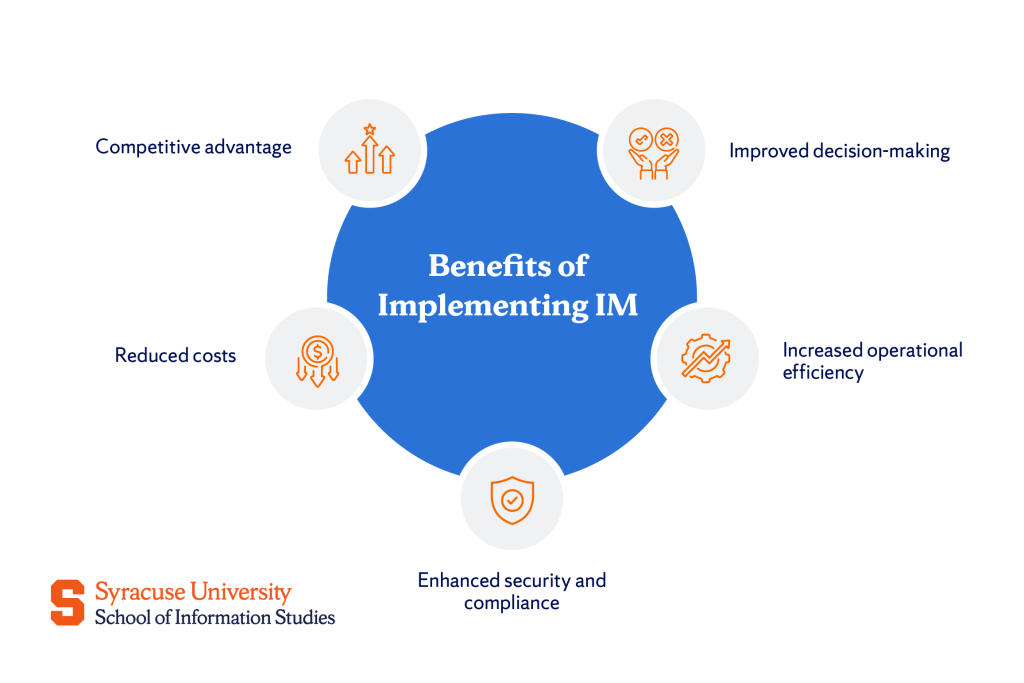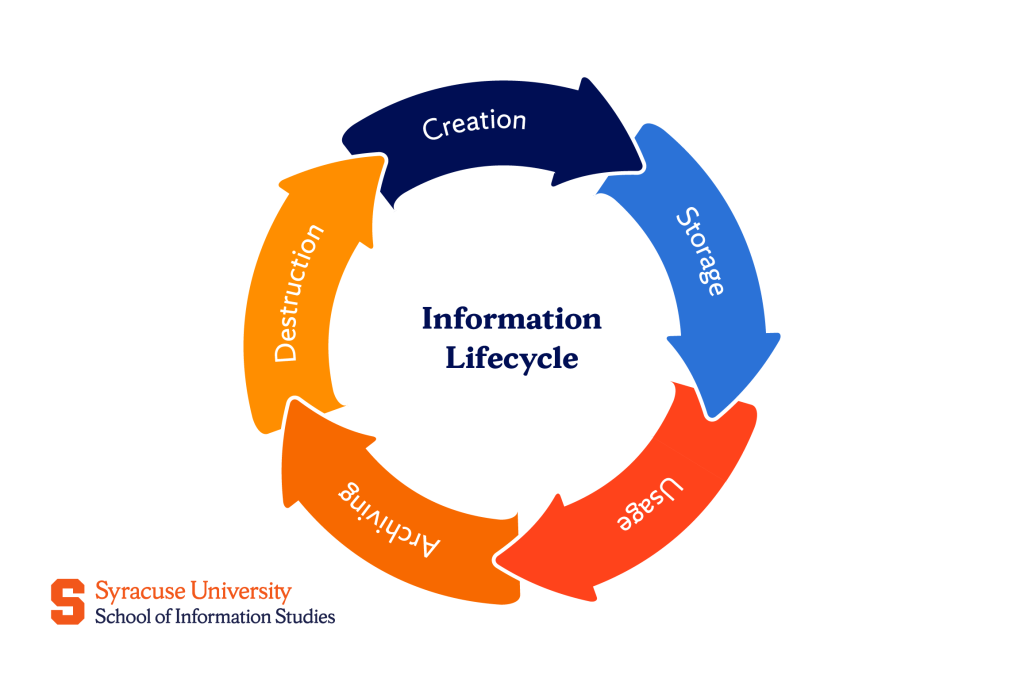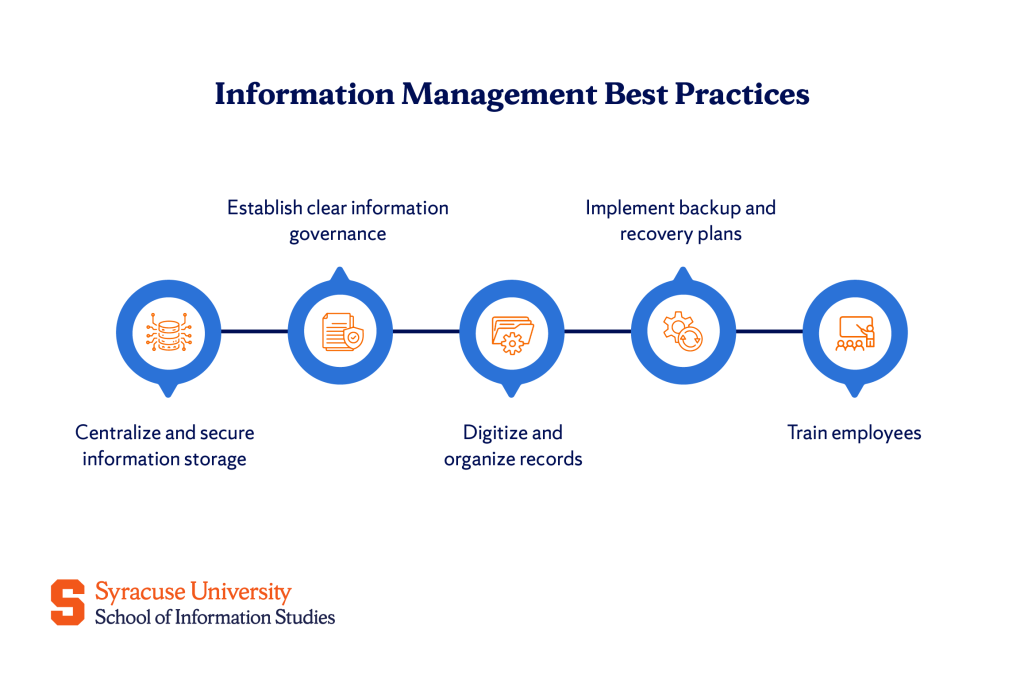Key Takeaways
- Information management is the discipline of collecting, organizing, and controlling information so it remains accurate, accessible, and useful.
- When implemented well, information management improves decision-making, increases efficiency, strengthens security, lowers costs, and creates a competitive advantage.
- Best practices for implementing IM include centralizing storage, setting clear governance rules, digitizing records, maintaining reliable backups, and training employees effectively.
Organizations generate and consume massive amounts of information. A single company might handle thousands of customer emails, prepare pages of financial reports, circulate strategic planning documents, and archive compliance records required by regulators.
Each stream of information is necessary for daily operations, yet the sheer volume can be difficult to control. What has the potential to be a valuable resource often turns into a source of inefficiency and risk when it is scattered, duplicated, or poorly organized. This challenge is exactly what information management addresses.
What Is Information Management
Information management (IM) is the practice of collecting, organizing, and controlling information so as to guarantee that information is reliable and accessible when it is needed. This might sound straightforward, but for organizations handling thousands of emails, financial records, contracts, and customer files, it quickly becomes a complex responsibility.
IM is primarily concerned with three key pillars: people, processes, and technology.
People are at the center of information management. They are the ones who create information in their daily work, rely on it to make decisions, and follow rules that ensure it stays accurate and secure. Their actions determine whether information builds trust and efficiency or leads to confusion and risk.
Processes set the rules for handling information throughout its life cycle, from the moment it is created until it is no longer needed. They ensure that information is stored consistently, shared responsibly, and eventually disposed of in a controlled way.
Technology provides the tools that make information management possible. These tools include databases for storing large volumes of data, cloud platforms that enable access across multiple locations, analytical systems that transform raw data into actionable insights, and security applications that protect sensitive records. They make it possible to handle information consistently and at scale.
Key Benefits of Effective Information Management
When organizations consider adopting or investing in new practices, it often comes down to one question: What are the benefits? Understanding the tangible outcomes of information management enables leaders to build internal support and justify the associated costs.
The advantages of effective information management reach across every part of the business, from leadership decisions to frontline efficiency.

Improved decision-making
Strong information management helps organizations have more accurate and timely information. With organized and accessible data, decision-makers can track patterns in customer behavior, detect inefficiencies in operations, and assess financial risks before they become serious issues. With reliable information at hand, organizations can make choices supported by facts rather than assumptions.
Data-driven organizations are reported to be 23 times more likely to acquire customers and six times more likely to retain them. The figures highlight a direct connection: organizations that manage information well are better at attracting and keeping customers, which directly impacts revenue and growth.
Increased operational efficiency
Poor information management wastes enormous amounts of time. Studies show that the average worker spends 3.2 hours every week searching for information they should already have access to. Over the course of a year, that adds up to more than 166 hours per person, which is equivalent to over an entire month of full-time work.
The problem becomes even bigger when scaled to a team. For a group of 50 employees, this wasted time amounts to 8,320 hours per year, the equivalent of four full-time employees doing nothing but searching for files and data.
This waste represents both direct salary costs and lost productivity. Information management eliminates much of this inefficiency by ensuring information is organized, centralized, and easy to retrieve.
However, findings show that companies that implemented structured IM systems saw a 20% increase in employee productivity within the first year. Instead of hunting through disorganized folders, employees can use that time to serve customers, improve products, or drive growth instead of hunting through disorganized folders.
Enhanced security and compliance
Information management also helps in protecting sensitive material and meeting regulatory requirements. Laws like the General Data Protection Regulation (GDPR) in Europe, the Health Insurance Portability and Accountability Act (HIPAA) in the United States, and the Sarbanes–Oxley Act (SOX) for financial reporting all demand that organizations handle data responsibly. Failure to do so can result in heavy fines, reputational damage, and loss of customer trust.
Good IM practices support security through access controls that limit who can view sensitive records, audit trails that document how information is used, and retention policies that define how long data must be kept. These measures help reduce the risk of breaches and demonstrate compliance during regulatory audits.
Reduced costs
Avoiding fines is only one way information management helps reduce costs. When files are scattered without oversight, organizations end up keeping multiple versions of the same document or holding on to outdated records far longer than necessary. Over time, this creates unnecessary storage costs, especially in cloud environments where space is directly tied to fees.
Costs also arise from duplicated effort. Employees often redo work that already exists because they cannot find the original or are unaware that another team has already completed it. Structured information management reduces this problem by making accurate, up-to-date records easy to locate. Instead of paying twice for the same work, organizations can direct those hours toward more valuable initiatives.
Gaining a competitive advantage
Perhaps the most strategic benefit of information management, which essentially encompasses all the other benefits into one, is how it positions an organization against its competitors. When information is well-managed, businesses can track shifts in customer demand, adapt products quickly, respond to market changes faster than others, and generally be more productive.
This advantage compounds over time. Organizations that treat information as a managed resource continually refine their operations and sharpen their insights, while those without effective systems are forced to make slower, less informed decisions.
The Information Lifecycle Explained
All information follows a predictable lifecycle, and understanding these stages is fundamental to managing it effectively. Each stage calls for its own methods and supporting technologies.

Information creation or capture
The lifecycle begins when information first enters an organization. Creation happens when employees produce new material, such as reports, presentations, or detailed project plans. Capture occurs when outside information flows in, like customer inquiries, vendor contracts, or industry research.
Modern organizations handle both structured data (for example, numbers in spreadsheets or databases) and unstructured content (such as emails, documents, or video files). Big data volumes grow exponentially each year, making control at this stage increasingly important.
Storage and organization
After creation, information needs a secure place to be stored. This involves selecting appropriate storage systems, establishing clear folder structures, and applying metadata or labels so that information can be retrieved later.
Cloud-based systems are especially valuable here because they allow organizations to scale capacity, provide remote access, and support recovery options in case of system failure.
Curation and usage
At this stage, information delivers its greatest value. Data is examined, connected with other sources, and applied to guide decisions. Data visualization tools help present trends clearly, while data analytics platforms reveal patterns that might otherwise remain hidden.
The focus is on turning raw information into insight that supports daily operations and long-term strategy.
Archiving
Some information eventually becomes less relevant to daily work but must still be kept for compliance or reference. Archiving places this material in long-term storage that emphasizes preservation and cost efficiency rather than speed of access. Effective archiving balances the need to meet legal or regulatory requirements with the practical goal of controlling storage expenses.
Destruction
When information reaches the end of its lifecycle, it must be permanently removed in a secure and verifiable way. This stage involves documented processes that confirm complete deletion while maintaining audit records for accountability. Proper destruction protects sensitive data and reduces liability.
Information Management vs Data Management vs Knowledge Management
Because these terms all involve “management” and revolve around data, information, and knowledge, they are often mixed up. Yet, while related, each plays a distinct role. Understanding the differences helps clarify how they fit together in practice.
Information management vs. Data management
Data represents raw, unorganized facts, like numbers in a spreadsheet or individual transaction records. On its own, it has little meaning. However, once that data is organized and given context, it becomes information, like a chart that shows quarterly sales trends or a report summarizing customer feedback.
This distinction established the difference between the two fields, too. Data management focuses on the technical foundation, like keeping raw data accurate and organized in the systems that hold it. Then information management builds on that base by adding context and processes that turn data into material people can actually use.
Information management vs. Knowledge management
Information is tangible, something that can be written down, stored in systems, and transferred between people. Knowledge, however, includes the intangible human element: experience, expertise, intuition, and insight that exists in people’s minds.
Because of this, the two forms of management are connected but not interchangeable. Information management ensures that documents, records, and data are organized and accessible, giving employees a reliable base to work from. Knowledge management builds on that base by encouraging people to share their insights, whether through mentoring, collaborative platforms, or professional communities.
The relationship is complementary. Without strong information management, knowledge management lacks trustworthy reference material. Without knowledge management, information remains static and underutilized, missing the value that comes from human interpretation and application.
Best Practices for Implementing Information Management
To actually experience the potential benefits that can come from information management, it’s not enough to just install new systems or buy new tools. Success depends on how well the organization puts those systems into practice.
The best practices for implementing information management include:

Centralize and secure information storage.
Bringing information together in one controlled system means that all employees can access the most up-to-date version. Cloud-based document platforms make this possible by allowing storage in a single location while still controlling who can see or edit each file. This setup improves collaboration and cuts down on wasted storage.
Establish clear information governance
Technology alone cannot solve information problems. Organizations need clear rules for how information is handled. Data governance functions as a rulebook that sets policies for who has access to certain files, how long records should be kept, and how information should be disposed of once it is no longer needed. With this framework in place, compliance with laws or regulations becomes far easier.
Digitize and organize records
Convert critical paper documents into searchable digital formats. This step dramatically improves accessibility while reducing physical storage costs and security risks.
Once digital, information should be arranged logically with clear naming conventions, folder structures, and tagging standards. This way, employees spend less time searching and more time using the material.
Implement robust backup and recovery plans.
Losing access to important information can bring work to a halt. Studies indicate that 93% of companies that lose access to their data for more than 10 days are unable to fully recover and go bankrupt within a year.
To prevent this, organizations need automated backup systems that are tested regularly. Strong plans combine local copies, cloud storage, and written recovery steps so information can be restored quickly if disaster strikes.
Train employees on best practices
The success of information management depends as much on people as on technology. Employees interact with information every day, so the way they handle it directly affects accuracy and security. Training gives staff the knowledge to carry out these tasks consistently and responsibly.
Practical training includes showing employees where and how to store files, how to use naming conventions, and how to follow access rules. It should also build awareness of basic cybersecurity practices, such as spotting suspicious emails or creating strong passwords.
Conclusion
Information management is essential for any organization that wants to thrive in the digital age. Because it is so central to long-term success, IM has also become one of the most promising career paths in technology.
At Syracuse University’s iSchool, students can prepare for these roles through programs like the Information Management and Technology Bachelor’s Degree or the Doctor of Professional Studies in Information Management. These programs combine technical skills with business understanding in order to equip graduates to manage data, design systems, and lead teams in ways that create real value.
The experience of iSchool alumnus Jordan Leuenberger reflects this preparation. His goal is to work in information management and data analytics with a focus on project management. He praised the school for feeling prepared for his future, saying: “Syracuse has equipped me exceptionally well for the future. The university’s career services and academic advising have been invaluable.”
Information can be a burden or a strength. Join us and build the skills to make it work for people, not against them.
Frequently Asked Questions
What are the main challenges in information management?
The biggest challenges include handling rapidly growing data volumes, maintaining information security, meeting compliance requirements, and ensuring that employees can quickly access what they need.
How is AI changing information management?
AI is automating tasks like sorting, tagging, and analyzing data, making information easier to organize and turning large datasets into actionable insights much faster.
What skills are needed for a career in information management?
Key skills include organizing and analyzing data, understanding information systems, ensuring security and compliance, and communicating clearly so information supports decision-making.
